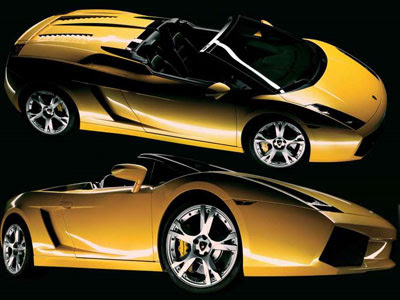
Lamborghini Gallardo Spyder
Lamborghini Gallardo Spyder 10-cylinder 4961 cc Engine and six-speed gearbox The
Sports Car Coupe.Two years after the launch of the
Coupé version of the
Gallardo, Automobili
Lamborghini had presented the
Lamborghini Gallardo Spyder at the 2005 Frankfurt Motor Show.
The
Lamborghini Gallardo Spyder is not just an open-top version of the
Coupé, but is a completely new model. It has an attractive new design and a unique system for opening and closing the fabric roof that utilises the engine compartment to store the folded roof.
The dimensions of the
Gallardo, combined with its competitive performance targets, ensure the car has an athletic compactness. The long wheelbase complemented by short overhangs dynamise its appearance. The
Lamborghini Gallardo Spyder features typical and unique mono-volume proportions, which integrate the
Lamborghini design attributes of purism, athleticism and sharpness.
The roof raising/lowering system of the
Lamborghini Gallardo Spyder is based on an electronic control system with electrohydraulic actuators and comprises
The roof raising/lowering mechanism is extremely simple to operate by way of two push-buttons on the centre of the dashboard. And the whole operation takes just over 20 seconds.
The rear screen moves automatically while the roof is being opened or closed. This automatically-controlled movement always returns the screen to the raised position. The driver can also choose to have the screen in the lowered position (also with the roof raised) by pressing the appropriate button on the dashboard.
There is also a "service function" that positions the roof so as to allow access to the engine.

Lamborghini Gallardo Spyder
Great care has been taken over the structural design of the
Gallardo Spyder, which of course complies fully with all the relevant safety standards.
The space frame has been reinforced in the area of the sills and the A pillars have been strengthened with the adoption of an automatic Roll Over protection system (comprising two "pop-ups") integrated with the air bag system.
All these solutions, which place Lamborghini at the very forefront of open top car design, were driven by the need to present to the public a true spyder characterised by a pure design.
The new
Lamborghini Gallardo Spyder features a number of important modifications to the original engine and transmission from the Coupé.
The 10-cylinder 4961 cc propulsion unit now develops 520 hp (382 kW) at 8,000 rpm.
The six-speed gearbox now has lower ratios (1st gear is 27% lower, 2nd gear is 13%, 3rd / 4th / 5th gears are all 6% lower, while 6th gear is 3.5% lower), which create a more dynamic performance.
And finally, its performance figures: the
Lamborghini Gallardo Spyder - which complies with
EURO 4 homologation standards - reaches a top speed of 314 km/h with the roof up and 307 km/h with the roof down, accelerating from 0 to 100 km/h in 4.3 seconds.



